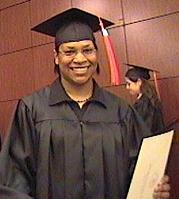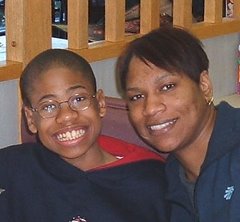Signs of autism can be seen in infants
http://www.kentucky.com/mld/kentucky/living/health/11235477.htm?template=contentModules/printstory.jsp
By Julie Deardorff
CHICAGO TRIBUNE
Like many new mothers, Tina Fougere kept a diary after her twins were born. With great joy, she traced their tiny feet. She diagramed their sprouting teeth. And she diligently chronicled first steps, first words and first birthdays.
What Fougere didn't know at the time was that her son, Nathan, was autistic. The personal journals, which detailed everything from sleep patterns to facial expressions in the two children, have become illuminating scientific documents that show autism can be seen in children as young as 6 months.
Autism, a devastating and confounding neurological disorder, is rarely diagnosed before age 2 and often not until age 3 or 4. The findings generated from the diaries, published in last month's scientific journal Neurocase, offered an unprecedented glimpse at the early warning signs.
The information can be crucial to early intervention. But these red flags also give parents even more to worry about if a child isn't developing precisely on schedule. Boys and girls are notorious for reaching milestones at different times.
Now, in addition to tracking a child's height and weight, the U.S. Centers for Disease Control and Prevention want parents to note when their child smiles, how often, when the child starts to speak, when he learns to play and how he interacts with others.
Are the signs reliable?
Specific therapies haven't been designed for children who show autism symptoms when they are younger than 1. And there is growing concern that pediatricians aren't adequately trained to diagnose children with neurodevelopmental disorders.
"It's a new area, and we're still asking the question: Are the signs reliable enough to predict?" said Mel Rutherford, an assistant professor of psychology at Ontario's McMaster University, who studied the Hamilton, Ontario, mother's journals. "The danger is not whether we (diagnose) too early. The danger is not being accurate."
The number of children who have a condition in the autism spectrum is staggering. In the 1980s, it was thought that one in 2,500 had one. It's now one in 166, according to recent CDC estimates. Yet no one can explain why.
Instead, the effort is focused on early diagnosis. Last month, the CDC launched a campaign, "Learn the Signs. Act Early" (www.cdc.gov/ actearly) to teach parents the signs of normal development.
By 15 to 18 months, for example, a child should be able to say several single words, according to the guidelines. But what parents should know is that autistic children have delays in all forms of communication -- verbal and non-verbal. A lack of words at 15 to 18 months isn't necessarily cause for concern as long as he can point and grunt to show parents what he wants.
"If a whole suite of skills is not coming or is late, then you should start to wonder what is going on," Rutherford said.
Warnings often subtle
In Fougere's case, the twins appeared to develop normally for the first six months. Both smiled, were vocally responsive and showed a preference for family members over others, Rutherford said. Nathan even crawled and walked before his sister.
By age 1, however, Nathan showed less eye contact, less verbal communication and less affection toward others than his sister. In hindsight, a telling moment for Fougere was when Nathan seemed uninterested in his first birthday party.
Still, warning signs are rarely obvious. Betsy Marks' 3-year-old son, Jonah, developed normally for the first year and began speaking. At 13 months, the eight words he knew vanished from his vocabulary. But the changes were subtle. "We thought he wasn't talking and he was fussier because he broke his leg (about that time)," said Marks of Highland Park, Ill. "It happened really slowly."
© 2005 Lexington Herald-Leader and wire service sources.
For more information and resources on autism, go to: http://www.autismconcepts.com/.
Forget what you haven't heard… Family site shares news, resources, announcements and free or low-cost ways to help us manage day-to-day living with autism.
Crystal Brown

About Me

- Crystal
- AutismConcepts.com and Child-Autism-Parent-Cafe.com share a large collection of useful autism information, resources, and how-to articles written by authors who are touched by autism, offering practical solutions to families. Particularly minority and underserved families and caregivers who may not know what to do or where to go for help.
MJ And Me

Blog Archive
-
▼
2005
(194)
-
▼
March
(44)
- Signs of autism can be seen in infants
- Study: Autism linked to mirror neuron dysfunction
- The David Center Scholarship for Parents or Guardians
- Autism's echoes fill this home (Article on family ...
- Autism - Mercury Poisoning, Epidemic levels breach...
- Mass Drugging of School children: The Dark Secret ...
- New BOCES Report Cards
- Pick Your Poison - New Republic article on mercury
- Traveling tips for families with an autistic child...
- UC M.I.N.D. Institute Report on Autism Rates in CA
- Videos to IOM Immunization Safety Review Committee...
- Study: Environmental Mercury Release, Special Ed R...
- African-American families more accepting of home s...
- Study: Mercury Pollution, Autism Link Found
- National Vaccine Injury Compensation Program Impro...
- New flu vaccine for kids hits the market
- First Alert Door Alarm
- Autism News Report - FOX News and IMUS
- The Age of Autism: Backward
- Navigating Medicare and Medicaid, 2005: Resource G...
- Key Facts: Race, Ethnicity & Medical Care
- The Role of Health Coverage for People with Disabi...
- Committee on Government Reform Autism Hearings
- The Mercury Calculator
- New Proposed Bankruptcy Legislation Will Hurt Pare...
- Study: MMR Japan study versus Wakefield and Stott ...
- Study: US study confirms bowel disease findings in...
- Study: Eye contact triggers threat signals in auti...
- U.S. Autism Rates Rise Sharply
- CDC Finally Takes Action on Dangers of Common Chil...
- Racial Inequity in Special Education, Civil Rights...
- Educating Children with Autism, Nat'l Academies of...
- Minorities Get Inferior Care Even if Insured Study...
- Aid for autism
- "Talking About Medicare," New Online Guide
- A User-Friendly Vaccination Schedule
- "Mercury in Medicine" Report, U.S. Gov't. Reform C...
- Individuals with Disabilities Education Act (IDEA)...
- "Special Education: Children with Autism", GAO Report
- Free Online Advocacy Program
- Autism Radio
- Free Newsletters from Autism Research Institute
- Need help getting a computer or Internet service?
- Are We Giving Children All They Need?
-
▼
March
(44)